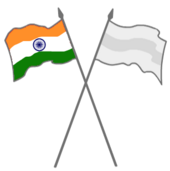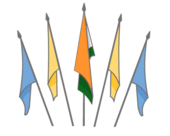Indian National Flag Display with Flags of Other Nations


1. When displayed in a straight line with Flags of other countries, the National-Flag shall be on the extreme right; (i.e.) if an observer were to stand in the centre of the row of the flags facing the audience, the National-Flag should be to his extreme right. Flags of foreign countries shall proceed as from the National-Flag in alphabetical order on the basis of English versions of the names of the countries concerned. It would be permissible in such a case to begin and also to end the row of flags with the National-Flag and also to include the National Flag in the normal country wise alphabetical order. The National-Flag shall be hoisted first and lowered last.
2. In case flags are to be flown in an open circle, i.e., in an arc or a semi-circle, the same procedure shall be adopted, as is indicated in the preceding paragraphs. In case flags are to be flown in a closed, i.e., complete circle, the National-Flag shall mark the beginning of the circle and the flags of other countries should proceed in a clockwise manner until the last flag is placed next to the National-Flag. It is not necessary to use separate National-Flags to mark the beginning and the end of the circle of flags. The National-Flag shall also be included In Its alphabetical order in such a closed circle. When the National-Flag Is displayed against a wall with another flag from crossed staffs, the National-Flag shall be on the right (i.e.) the flag's own right, and Its staff shall be in front of the staff of the other Flag.
3. When the United Nations' flag is flown along with the National-Flag, it can be displayed on either side of the National-Flags. The general practice is to fly the National Flag on the extreme right with reference to the direction which it Is facing (i.e. extreme left of an observer facing the masts flying the flags.)
4. When the National-Flag Is flown with flags of other countries, the flag masts shall be of equal size. International usage forbids the display of the flag of one nation above that of another nation in time of peace.
5. The National-Flag shall not be flown from a single masthead simultaneously with any other flag or flags. There shall be separate mastheads for different flags.
6. On occasions specified by the Government, such as the visit of a foreign dignitary, the general public may wave the National-Flag made of paper and the paper flag of the other country. After use. they shall be disposed of in a proper manner preferably by burning in private.
7. With permission of the Government, the National Flag and the flags of other countries may be displayed on occasions such as cultural shows, exhibitions, musical concerts, film festivals, etc., sponsored by the diplomatic or consular representatives of foreign governments.
8. A foreigner or a foreign firm/institution may fly the National-Flag of India along with the flag of his/its country on the Indian National days or his/its own country's national days, in accordance with the procedure indicated above.

